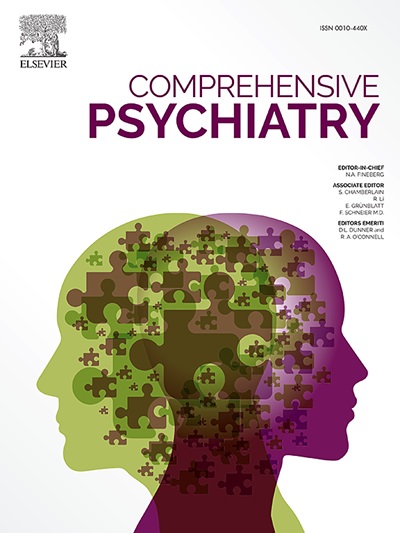通过内隐认同和控制偏差探索自杀行为:来自死亡-内隐关联测试及其新控制适应的发现
IF 4.2
2区 医学
Q1 PSYCHIATRY
引用次数: 0
摘要
目的探讨两种死亡-内隐联想测验版本在自我概念(标准同一性D-IAT;iD-IAT)和内部与外部对照(适应对照D-IAT;cD-IAT)和自杀未遂者的死亡率。此外,还探讨了显式心理变量和心理测量的相关性。方法116例精神科住院患者(女性58.1%;年龄M = 33.6, SD = 12.4)分为单次与多次、近期与终生自杀企图者。使用iD-IAT和cD-IAT测量内隐关联。自我报告测量包括与自杀行为相关的构念。结果近期尝试者的自我寿命(t(114) = 2.18, p = 0.016)和内部控制寿命(t(114) = 2.26, p = 0.013)的相关性较终身尝试者弱。多重尝试者比单一尝试者表现出较弱的内部控制寿命相关性(t(114) = 2.25, p = .007)。iD-IAT与自杀意念(rs(114) = 0.20, p = 0.032)、抑郁(rs(114) = 0.20, p = 0.033)、外部控制(rs(114) = 0.21, p = 0.021)、cD-IAT与自杀意念(rs(114) = 0.25, p = 0.006)、抑郁(rs(114) = 0.26, p = 0.006)相关。cD-IAT预测多次尝试(χ2(1116) = 3.88, p = 0.049),具有较高的内部一致性(rsb =。31, p = .001)和检测多个的预测效度(AUC = 0.64;p = 0.013)和近期(AUC = 0.62;p = .028)。结论cD-IAT显示了基于近期和频率区分自杀行为的初步潜力,为理解高危亚组的认知脆弱性提供了试试性的一步,需要进一步的改进、验证和前瞻性分析。本文章由计算机程序翻译,如有差异,请以英文原文为准。
Exploring suicidal behaviour through implicit identity and control biases: Findings from the Death-Implicit Association Test and its novel control-adaptation
Objective
This study examined two Death-Implicit Association Test versions targeting associations between the self-concept (standard identity D-IAT; iD-IAT) and internal versus external control (adapted control D-IAT; cD-IAT) and death among suicide attempters. Additionally, correlations with explicit psychological variables and psychometrics were explored.
Method
116 psychiatric inpatients (58.1 % female; age M = 33.6, SD = 12.4) were classified as single versus multiple and recent versus lifetime suicide attempters. Implicit associations were measured using the iD-IAT and cD-IAT. Self-report measures included constructs relevant to suicidal behaviour.
Results
Recent attempters showed weaker self-life (t(114) = 2.18, p = .016) and internal control-life (t(114) = 2.26, p = .013) associations than lifetime attempters. Multiple attempters exhibited weaker internal control-life associations than single attempters (t(114) = 2.25, p = .007). The iD-IAT correlated with suicidal ideation (rs(114) = 0.20, p = .032), depression (rs(114) = 0.20, p = .033) and external control (rs(114) = 0.21, p = .021), the cD-IAT with suicidal ideation (rs(114) = 0.25, p = .006) and depression (rs(114) = 0.26, p = .006). The cD-IAT predicted multiple attempts (χ2(1116) = 3.88, p = .049), showed higher internal consistency (rsb =. 31, p = .001) and predictive validity in detecting multiple (AUC = 0.64; p = .013) and recent (AUC = 0.62; p = .028) attempters than the iD-IAT.
Conclusions
The cD-IAT shows preliminary potential to differentiate suicidal behaviour based on recency and frequency, offering a tentative step toward understanding cognitive vulnerabilities of at-risk subgroups, warranting further refinement, validation and prospective analyses.
求助全文
通过发布文献求助,成功后即可免费获取论文全文。
去求助
来源期刊

Comprehensive psychiatry
医学-精神病学
CiteScore
12.50
自引率
1.40%
发文量
64
审稿时长
29 days
期刊介绍:
"Comprehensive Psychiatry" is an open access, peer-reviewed journal dedicated to the field of psychiatry and mental health. Its primary mission is to share the latest advancements in knowledge to enhance patient care and deepen the understanding of mental illnesses. The journal is supported by a diverse team of international editors and peer reviewers, ensuring the publication of high-quality research with a strong focus on clinical relevance and the implications for psychopathology.
"Comprehensive Psychiatry" encourages authors to present their research in an accessible manner, facilitating engagement with clinicians, policymakers, and the broader public. By embracing an open access policy, the journal aims to maximize the global impact of its content, making it readily available to a wide audience and fostering scientific collaboration and public awareness beyond the traditional academic community. This approach is designed to promote a more inclusive and informed dialogue on mental health, contributing to the overall progress in the field.
 求助内容:
求助内容: 应助结果提醒方式:
应助结果提醒方式:


